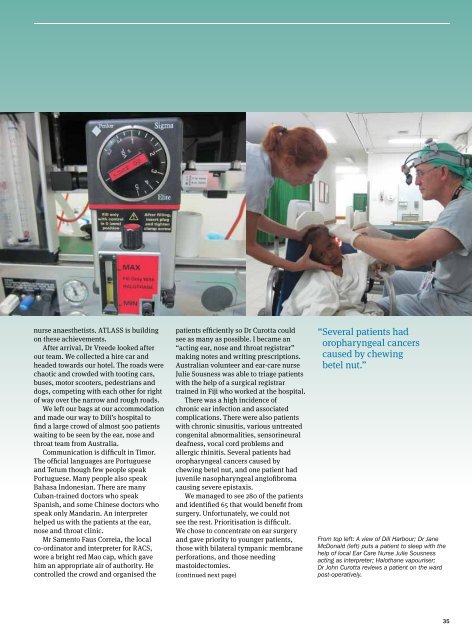ANZCA Bulletin June 2012 - final.pdf - Australian and New Zealand ...
ANZCA Bulletin June 2012 - final.pdf - Australian and New Zealand ...
ANZCA Bulletin June 2012 - final.pdf - Australian and New Zealand ...
- No tags were found...
You also want an ePaper? Increase the reach of your titles
YUMPU automatically turns print PDFs into web optimized ePapers that Google loves.
nurse anaesthetists. ATLASS is buildingon these achievements.After arrival, Dr Vreede looked afterour team. We collected a hire car <strong>and</strong>headed towards our hotel. The roads werechaotic <strong>and</strong> crowded with tooting cars,buses, motor scooters, pedestrians <strong>and</strong>dogs, competing with each other for rightof way over the narrow <strong>and</strong> rough roads.We left our bags at our accommodation<strong>and</strong> made our way to Dili’s hospital tofind a large crowd of almost 500 patientswaiting to be seen by the ear, nose <strong>and</strong>throat team from Australia.Communication is difficult in Timor.The official languages are Portuguese<strong>and</strong> Tetum though few people speakPortuguese. Many people also speakBahasa Indonesian. There are manyCuban-trained doctors who speakSpanish, <strong>and</strong> some Chinese doctors whospeak only M<strong>and</strong>arin. An interpreterhelped us with the patients at the ear,nose <strong>and</strong> throat clinic.Mr Samento Faus Correia, the localco-ordinator <strong>and</strong> interpreter for RACS,wore a bright red Mao cap, which gavehim an appropriate air of authority. Hecontrolled the crowd <strong>and</strong> organised thepatients efficiently so Dr Curotta couldsee as many as possible. I became an“acting ear, nose <strong>and</strong> throat registrar”making notes <strong>and</strong> writing prescriptions.<strong>Australian</strong> volunteer <strong>and</strong> ear-care nurseJulie Sousness was able to triage patientswith the help of a surgical registrartrained in Fiji who worked at the hospital.There was a high incidence ofchronic ear infection <strong>and</strong> associatedcomplications. There were also patientswith chronic sinusitis, various untreatedcongenital abnormalities, sensorineuraldeafness, vocal cord problems <strong>and</strong>allergic rhinitis. Several patients hadoropharyngeal cancers caused bychewing betel nut, <strong>and</strong> one patient hadjuvenile nasopharyngeal angiofibromacausing severe epistaxis.We managed to see 280 of the patients<strong>and</strong> identified 65 that would benefit fromsurgery. Unfortunately, we could notsee the rest. Prioritisation is difficult.We chose to concentrate on ear surgery<strong>and</strong> gave priority to younger patients,those with bilateral tympanic membraneperforations, <strong>and</strong> those needingmastoidectomies.(continued next page)“ Several patients hadoropharyngeal cancerscaused by chewingbetel nut.”From top left: A view of Dili Harbour; Dr JaneMcDonald (left) puts a patient to sleep with thehelp of local Ear Care Nurse Julie Sousnessacting as interpreter; Halothane vapouriser;Dr John Curotta reviews a patient on the wardpost-operatively.35
















